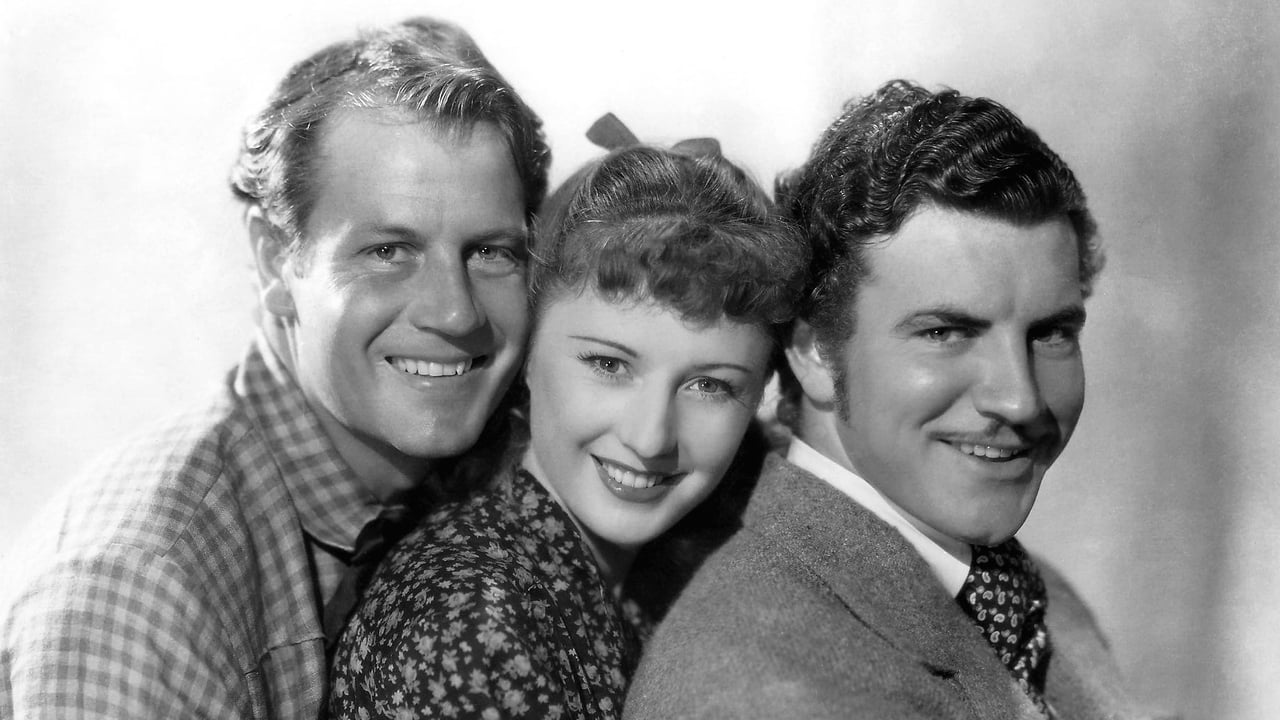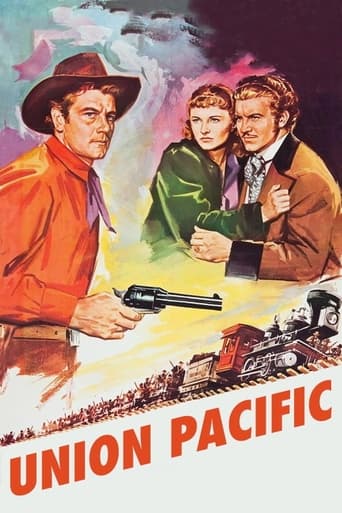

"Union Pacific" certainly starts off promisingly. Just in the first ten minutes DeMille presents a parade of character actors, extensive and expensive enough to furnish an entire Monogram movie. Unfortunately, things then settle down a bit whilst those two veteran scene-chewers Akim Tamiroff and Lynne Overman slowly masticate their way center stage. Wordy old J.M. Kerrigan doesn't help either. But interest perks up with that splendidly staged and photographed stunt which introduces Joel McCrea on to the train. The script is episodic and sprawling. We don't necessarily object to that, but what we don't like is that the big action climax (the Indians wrecking the train with the water tower) is followed by at least a half-hour more of further adventures (some of them exciting enough, it's true).What's worse is that the director muffs a number of splendid opportunities. The long-awaited climactic shoot-out for instance turns out to be a bit of a dud (and plot-wise it's just too pat and too convenient). Another example, is the wrecking of Donlevy's saloon, with most of the destruction taking place off-camera (though this economy is still reasonably effective). Despite these minor gripes and a number of technical shortcomings (such as the extensive use of the process screen, sometimes adroit, sometimes clumsily obvious), Union Pacific is most spectacularly staged. Not only is it full of action but has many scenes that work extremely well, both dramatically and cinematically. For example, the episode in which McCrea hunts for the stolen mail- bag in Stanwyck's car. The numerous camera set-ups and equally effective rapid cuts build tension up very nicely and make a great contrast with other scenes that are filmed in a single take. Yes, DeMille's direction is often at its most masterly and authoritative. He is particularly well served by his cast. The principals are agreeably sympathetic (though Miss Stanwyck's bogus Irish accent is a bit of a pain, and she is none too flatteringly photographed and costumed). The support cast headed by Donlevy is one of the best DeMille ever assembled. So wonderful in fact that DeMille can afford to waste top players like Charles Stevens and Lon Chaney Jr in single, fleeting shots. (Yet by the humble standards of his usual walking from right to left roles as railway porters, Sam McDaniel has a decent role for once as a waiter, with even one or two lines). As for Anthony Quinn, although he does play second fiddle to Donlevy's second henchman, Harry Woods (excluding Robert Preston of course who is actually a partner), he does have a great fade-out when he attempts to draw a pistol on McCrea in an early scene. Oddly but most effectively, Donlevy's number one cohort is Fuzzy Knight, usually cast in comic roles but here delightfully dangerous and sinister as a villain. We were also impressed by Sheila Darcy as Donlevy's moll. We could go on listing left, right and center, but will sign off with Henry Kolker, the best of all, who manages through sheer charm not only to make his perfidy acceptable but downright entertaining. He delivers his lines with a winning snakiness that is only rivaled by Wallace Beery at his Long John Silver best.Some unsung hero has contributed breathtaking 2nd unit photography. Love the payroll chase, with moon-clouded skies rimming across vast canyons. Also love the front rolling credits and the end shot of the modern Union Pacific train irising in, with "The End" title irising out. The music is appropriately railroady. Sets and costumes are elaborately realistic almost to a fault.
... View MoreStill another great 1939 film is "Union Pacific." The film, which is rich in history, is about the coming of the railroad linking the east and west and those who would do anything to destroy the construction of this mighty link.Barbara Stanwyck puts on an authentic Irish accent as lassie Mollie Monahan, and she is Mollie to a tee. Her love interests include Joel McRea as the overseer to make sure that the railroad is constructed, and his friend, Robert Preston, who unfortunately takes to the wrong side on this one, when he joins forces with always bad Brian Donlevy, a stooge for a financier who will stop at nothing to prevent the completion of this project.The film has everything-history, lust, a great train wreck, Indian uprisings and greed as well as desire.
... View MoreIn addition to his talents as a director, as a producer Cecil B. DeMille had a knack for simultaneously jumping on board the latest fad, and finding a niche that only he could fill. Union Pacific takes advantage of the 1939 Western revival, but while pictures like Stagecoach, Jesse James and Dodge City were still moderately-budgeted affairs, DeMille fulfils his obligation to make an epic Western, with thousands of extras, pyrotechnics and a two hour-plus runtime.DeMille may have been a savvy trend follower, but this didn't make him versatile as a director. What is particularly striking about Union Pacific, and indeed all of DeMille's Westerns, is that it does not show off the landscape. Most of the action takes place inside railway carriages or crowded gambling dens, and whenever the wilderness is glimpsed it seems merely coincidental, and is never breathtaking or evocative. Even in the handful of outdoor scenes, it appears DeMille only feels comfortable if he can build a wall of extras. But then again, choreography of crowds is part and parcel of DeMille's style, serving not only as a backdrop but as a part of storytelling method. Take for example the opening scene at the senate. While the anti-railroad speaker is talking, people mill about distractingly, as if discrediting his words. Then when Dodge speaks everyone in the background sits still, encouraging us to focus purely on him.While most of DeMille's silent pictures were penned by the brilliantly demented Jeanie Macpherson, for his sound features he had a revolving committee of untalented hacks. Union Pacific had no less than four credited screenwriters and three uncredited contributors, none of whom was especially prestigious, and the result is as dull as, if not duller than the average DeMille screenplay of this period. Unusually though it makes a few attempts at poignancy, most notably the scene in which Regis Toomey ("Paddy") gets shot. But what scuppers this scene as a genuine tearjerker is not the way DeMille shoots it, which is fairly sensitive, but its handling in the script. For one thing, there has not been enough establishment of this character and thus no emotional backdrop, and secondly Barbara Stanwyck's cod-poetic dialogue is corny even by 1930s standards.By and large though, DeMille's aim is as usual to dazzle and excite us, not to make us laugh or cry. Throughout his career he seldom dealt with emotional material, and here he shoots the dramatic scenes with functionality to give clarity to the story. With the increasingly sprawling narratives of the pictures he was now making, it was necessary to introduce little devices to help us keep track of the secondary characters, an example here being Brian Donlevy dipping his cigars in whiskey.As to the cast, DeMille always appears to have chosen actors for having the right look rather than bags of talent. Joel McCrea fits in with the pattern of handsome-yet-rugged types that made the lead men in DeMille's 1936-1947 output. Usually it would be Gary Cooper, and like Coop McCrea is by no means a bad actor, it's just that he requires a director who was a good acting coach to set him off. Barbara Stanwyck is a notch better, and she emotes well, but her attempt at an Irish accent and demeanour is grating. While there are some great names among the supporting cast, all of them are sadly below par here.Perhaps more than anything, Union Pacific fails because it does not really capture the spirit of the Western. Aside from DeMille's not making the most of the scenery, you just don't get a feel of the pioneer life. It doesn't make us believe that its characters ever had to camp out under the stars or came home covered in the dust of the plains. While some historical arenas were natural DeMille territory – Judea, ancient Rome, the Caribbean in the golden age of piracy – the old west is one he should have left alone.
... View MoreAmidst the glamour of "Gone With the Wind" and "The Wizard of Oz", this b&w Cecil B. DeMille Historical Fiction Classic received its share of eager 1939 movie theatre audiences. Starring a wholesome Irish immigrant Barbara Stanwyck, a noble law man Joel McCrae and a dashing dare devil Robert Preston, "Union Pacific" delivers a love-triangle centered around the historic 1869 joining of rail road tracks to connect the Western and Eastern borders of the United States. The love story is "formula", but delivers several "moments" where many viewers will fumble for their Kleenex. The climactic final scene showing the pay-off for all of the material and human sacrifices is priceless!The very last of DeMille's b&w ventures, Union Pacific is one of those gems that endured the test of time, endearing the "glorious black and white" to generations of viewers. I first saw this classic as a child; I loved it then, as I still do today. Of all of the Hollywood movies ever produced, no single year of film-making has ever stood out from the rest like 1939. "Union Pacific" helped solidify this status. A true Hollywood Classic!
... View More